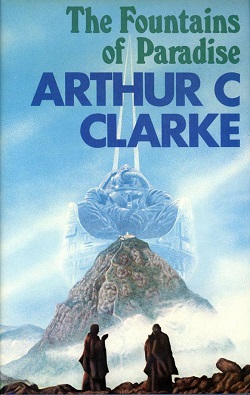 Cover of the first UK edition | |
| Author | Arthur C. Clarke |
|---|---|
| Cover artist | Terry Oakes |
| Language | English |
| Genre | Science fiction |
| Publisher | Victor Gollancz (UK) Harcourt Brace Jovanovich (US) |
Publication date | 1979 |
| Publication place | United Kingdom |
| Media type | Print (Hardback & Paperback) |
| Pages | 256 |
| ISBN | 0-575-02520-4 |
| OCLC | 4993570 |
The Fountains of Paradise is a 1979 science fiction novel by British writer Arthur C. Clarke. Set in the 22nd century, it describes the construction of a space elevator. This "orbital tower" is a giant structure rising from the ground and linking with a satellite in geostationary orbit at the height of approximately 36,000 kilometres (approx. 22,300 miles). Such a structure would be used to raise payloads to orbit without the expense of using rockets. The novel won both the Hugo [1] and Nebula [2] Awards for Best Novel.